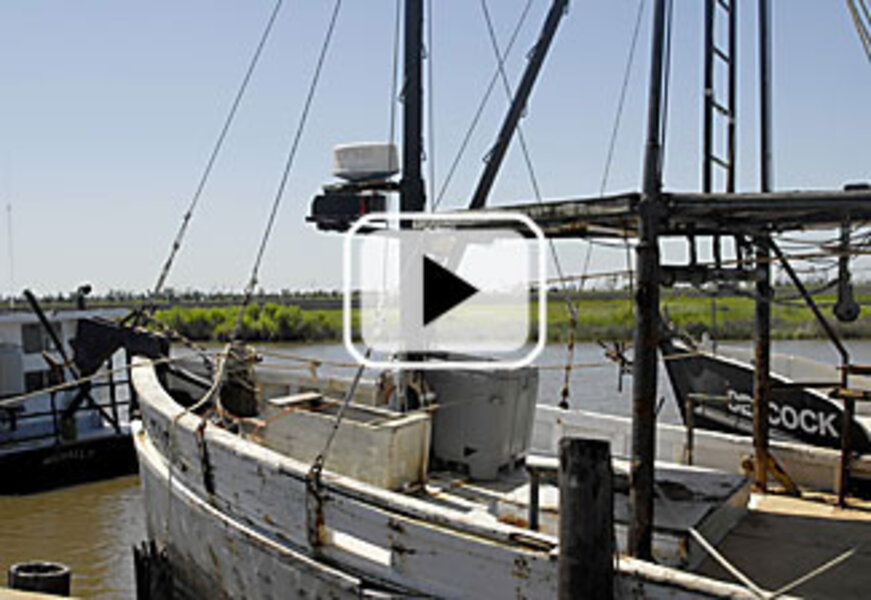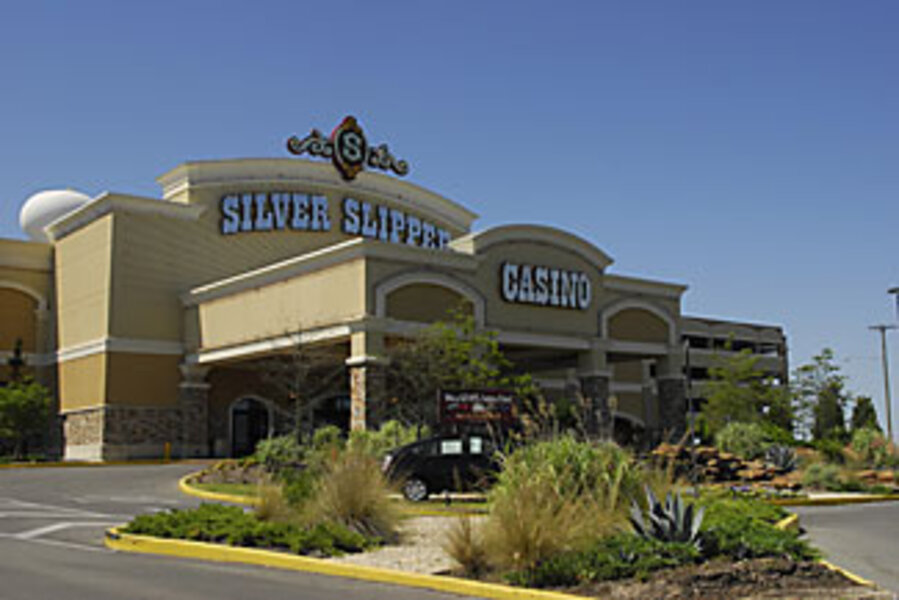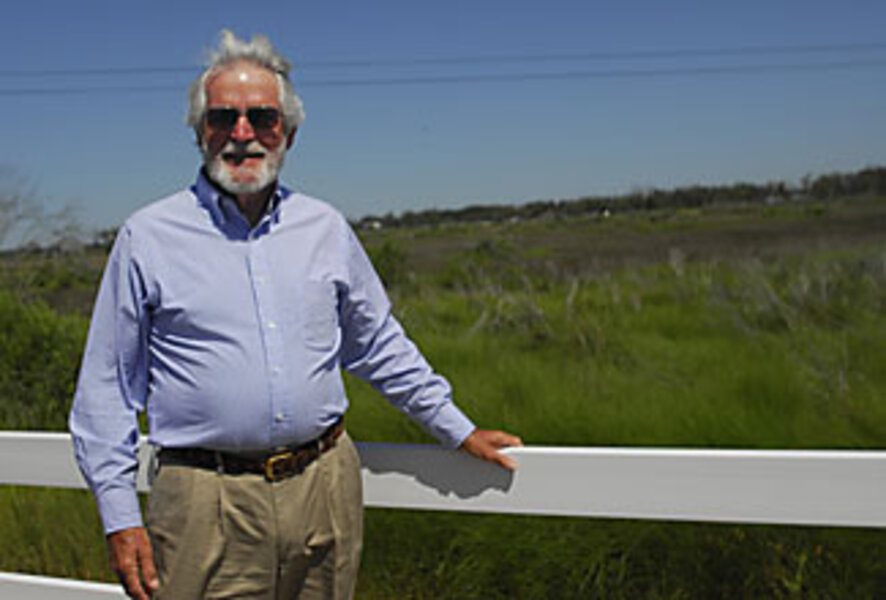Why a Gulf wetlands may become a city
Loading...
| Bayou Caddy, Miss.
If America learned one thing from hurricane Katrina, hydrologists argue, it should be this: Don't fill in tideland marshes and build on them. Such human activity, they insist, diminishes the marshes' ability to absorb some of the wallop of storms as they strike coastal communities.
Here on the westernmost reaches of Mississippi's marshes - the very place where Katrina rushed ashore on its path to becoming one of the worst natural disasters in US history - that lesson is being tested, with broad implications for US taxpayers who pay most of the bills for storm repairs.
Bob Metz, a crab dealer who plies the tidelands of Bayou Caddy, has only to look out from his boathouse to see, in the distance, the future: the new Silver Slipper Casino, its bright sign twinkling beneath a dark cumulous cloud stack.
To Mr. Metz, plans to augment the casino with a new condo city built on top of a tidal marsh is the prototype of a boondoggle waiting for a bailout. But local and state governments so far are backing the plan, and the US Army Corps of Engineers is considering a permit application to fill the spongy ground so the development will have firm footing. If approved, the permit would, quite literally, lay the groundwork for a project that could create the fourth-largest city on the Mississippi Gulf Coast.
"The big guys get what they want; that's the lesson I take from this," says Metz.
Another lesson might be that the dream of living on the ocean's edge dies hard. Some $80 billion in damages from Katrina apparently have not dampened it, nor have scientists' warnings that a $500 billion storm is possible in the US by 2020 and that the sea level may rise as much as three feet in the next century. So long as people gravitate to coastal living, political and economic pressures to allow it will rub up hard against the cautionary notes of scientists and environmentalists.
"The tough part is where the science leaves off and management and policy pick up," says Bryan Harper, senior economist at the Army Corps' Institute for Water Resources in Alexandria, Va. "We collectively use and enjoy the coast, but we have to understand what the balance is between what we get out of it and what is the real cost of occupying those areas. What we don't want is to induce development to areas that are not currently developed in these high-risk areas."
If history is any guide, developers and politicians who envision the revenue benefits of growth usually prevail – sometimes even in areas that most scientists would call "high risk." America's coastal counties have added 7 million people in the past five years, absorbing a little more than half the total US population growth in an area that makes up 17 percent of the US land surface, according to the National Oceanic and Atmospheric Administration.
Congress has contributed to the trend by assigning much of the risk of coastal living to the US government. The lawmaker-approved National Flood Insurance Program augments private insurance, and the Corps-administered Shore Protection Program in effect subsidizes construction of high-value structures on the beach by guaranteeing that fresh sand will be trucked in whenever storms carve into the headland.
US wetlands policy since 1988 has been to require developers who build on wetlands to mitigate the loss by creating or restoring wetlands elsewhere. But the overall goal of "no net loss" is failing, despite agencies' creation of tens of thousands of wetland acreage each year. The National Wetlands Inventory, by the US Fish and Wildlife Service, estimates that nearly 60,000 acres of wetlands are lost annually and that up to 80 percent of developers' mitigation projects fail. In Mississippi alone, the Army Corps is trying to restore some 3,000 acres of wetlands weakened by hurricane Katrina, to restore natural flow patterns and reduce the impact of any future storm surge.
For many, the Bayou Caddy proposal speaks to the power of market forces to erode a region's resolve to bolster its hurricane defenses – even with Katrina fresh in memory. The $750 million project, known as The Breezes of Paradise Bay, would eventually include as many as four high-rises studded with shops, arcades, restaurants, and residences. There would be room for perhaps 10,000 people in this "condo city" on the bayou – more than in the nearby towns of Waveland and Bay St. Louis combined.
Development of the scrubby marsh, now dotted with a few crab shacks and shrimp-boat docks, could be an economic boon to an area whose economy was shattered by Katrina, which is why the plan has broad political support. The developers said in a 2006 letter to the county that the project could add as much as $7.5 million annually to tax rolls.
What's more, proponents argue, condos built of concrete and steel would be better able to withstand a hurricane and could even serve as a man-made wind barrier that might protect properties further inland.
Rising land costs and the durability of high-rise towers are why resistance is diminishing to the idea of building condos on the coast, says developer Barney Creel of Gulfport. "What's the alternative?" asks Mr. Creel. "There's not a good alternative. I can understand how people don't want to see the small-town feeling go away, but it's just no longer financially feasible for that [residential] type of development down here. I think the realization of the feasibility of condos is sinking in."
The debate over Bayou Caddy cuts to the core of America's fixation with coastal living, says Orrin Pilkey, a Duke University professor and author of "The Corps and the Shore." At issue, he says, is whether the US should reduce the scale of the human profile on the coast, allowing smaller structures further inland, and off the marshes, instead of allowing large-scale construction directly on beach fronts.
"This is no time, in the context of rising sea levels and the expected increase in the rate of hurricanes, to be allowing condo development right on the shore," says Dr. Pilkey, a geologist specializing in coastal development.
"This is crazy. It gives the community no chance to move back, to let the big buildings go and let little buildings go in."
If the Corps grants the fill permit for the Bayou Caddy project, critics fear it will open the floodgates for other development on marshes. Some hydraulics engineers say the marshes helped to slow Katrina's ravaging path across Mississippi. Trucking in clay dirt to fill a marsh to build such structures is like encasing a sponge in plastic wrap, they argue. Skipping over soft ground made hard, any future flood surge would travel further onto land, exacerbating property damage deeper inland.
"If we don't nip this [project] in the bud, the pressure will be to develop more and more, and the Corps is critical to stopping that," says Bob Davis, a former Corps engineer and an agency critic.
Not all scientists agree that Mississippi's low-lying marshlands would do much to absorb the smack of a big storm.
"It's a concept that's stuck with the public, but the absorbency of the ground, when you look at the physics of how a storm surge works, has very little effect as what you might call a sponge," says Robert Twilley, director of the oceanography department at Louisiana State University in Baton Rouge. That doesn't mean the condo idea is a good one, he adds. The practice of filling some wetlands and creating others as "mitigation" nibbles away at the coast and undermines what Dr. Twilley calls "landscape integrity."
"The Army Corps still has not come to grips with that issue," he says.
The Corps, for its part, is going to make someone unhappy when it decides what to do about the Bayou Caddy fill permit. The stakeholders are many – politicians, state marine resources divisions, environmentalists, and landowners – and their interests are not always apparent.
With national coastal policy in flux, interest groups on both sides tend to hype their positions and stretch the facts, Twilley says.
"The public-policy sector has to be open-minded about the biases of their value system, which is the dollar, and [ask whether] the dollar really provides the best accurate condition of value when it comes to natural resources," he says. "What happens is you get forced into hyping functions of [economic development and natural resources] to build a level playing field, and that's a shame."
Meanwhile, the Army Corps, a military engineering agency best able to provide hard data on issues from natural surge protection to hydraulics research, is struggling to shift focus from building structural engineering projects to spearheading the debate over coastal policy. At the very least, the Corps needs to do a better job of informing the debate than it currently does, says one Corps spokesman. That aim is a major tenet of the agency's new internal "Actions for Change" program, which calls for the Corps to take a bigger role in setting coastal policy.
"The purpose of the risk-informed approach and risk communication is to make sure that for decisions made in these areas, even those not made by the Corps, people have information to see how those decisions might affect flood risk," says Mr. Harper, the Corps economist.
For the Breezes of Paradise Bay project, the winds may be shifting. Despite early support for the project, the Hancock County planning board recently clarified that structures higher than 12 stories will not be allowed at Bayou Caddy – a rule that may downscale the plan considerably.
The Corps, moreover, is taking a careful look at the permit application, with one spokesman saying there's no guarantee the project will get off the ground. A decision is expected in the next few months.
"If it's really high-quality wetlands, I don't know that you would or would not get the permit," says Pat Robbins, a Corps spokesman in Mobile, Ala. Bayou Caddy, he adds, "is probably pretty high-quality wetlands."








